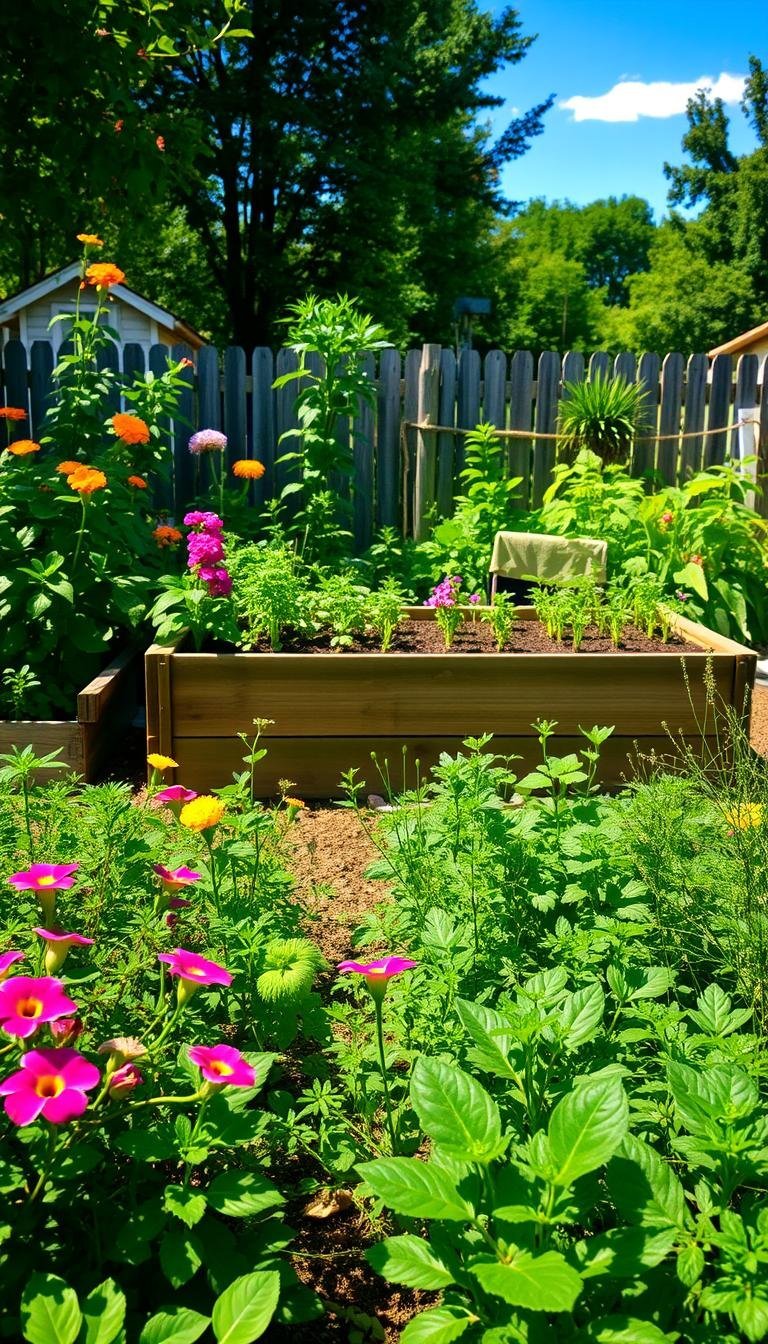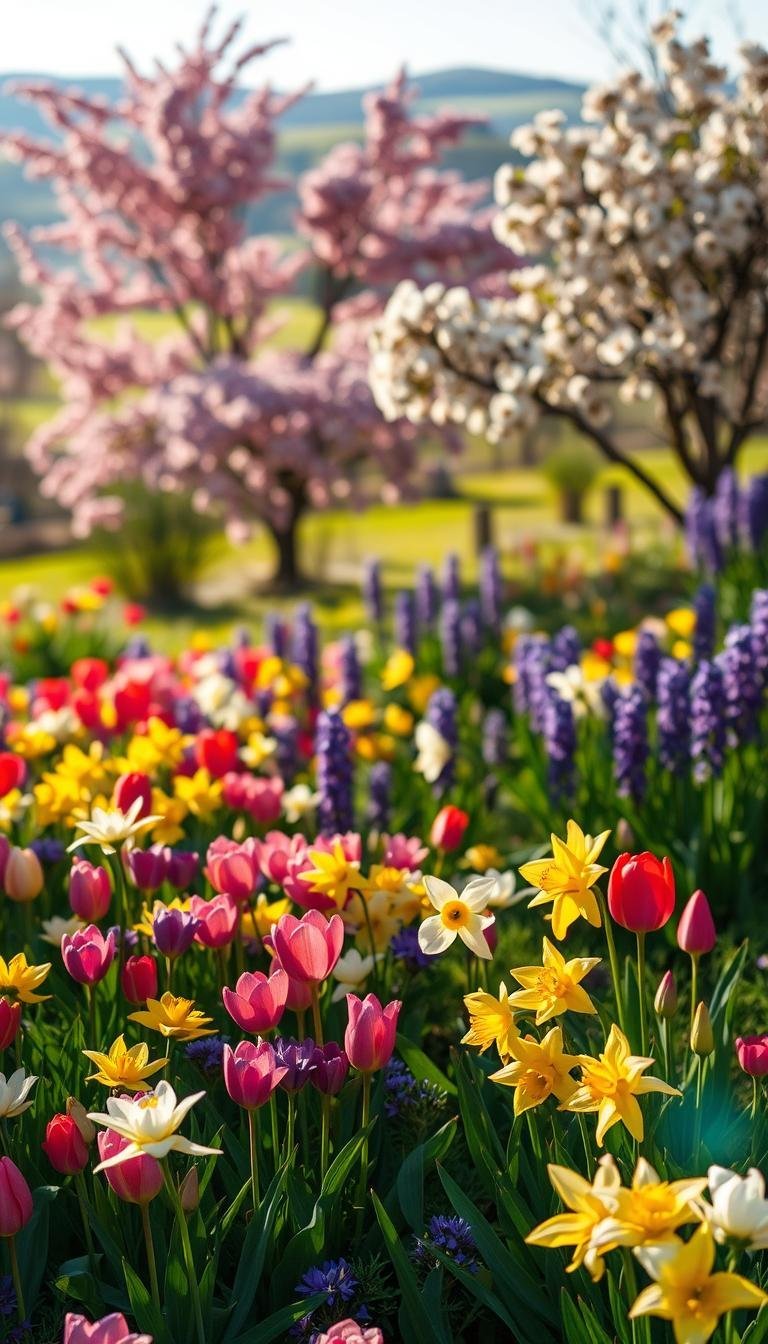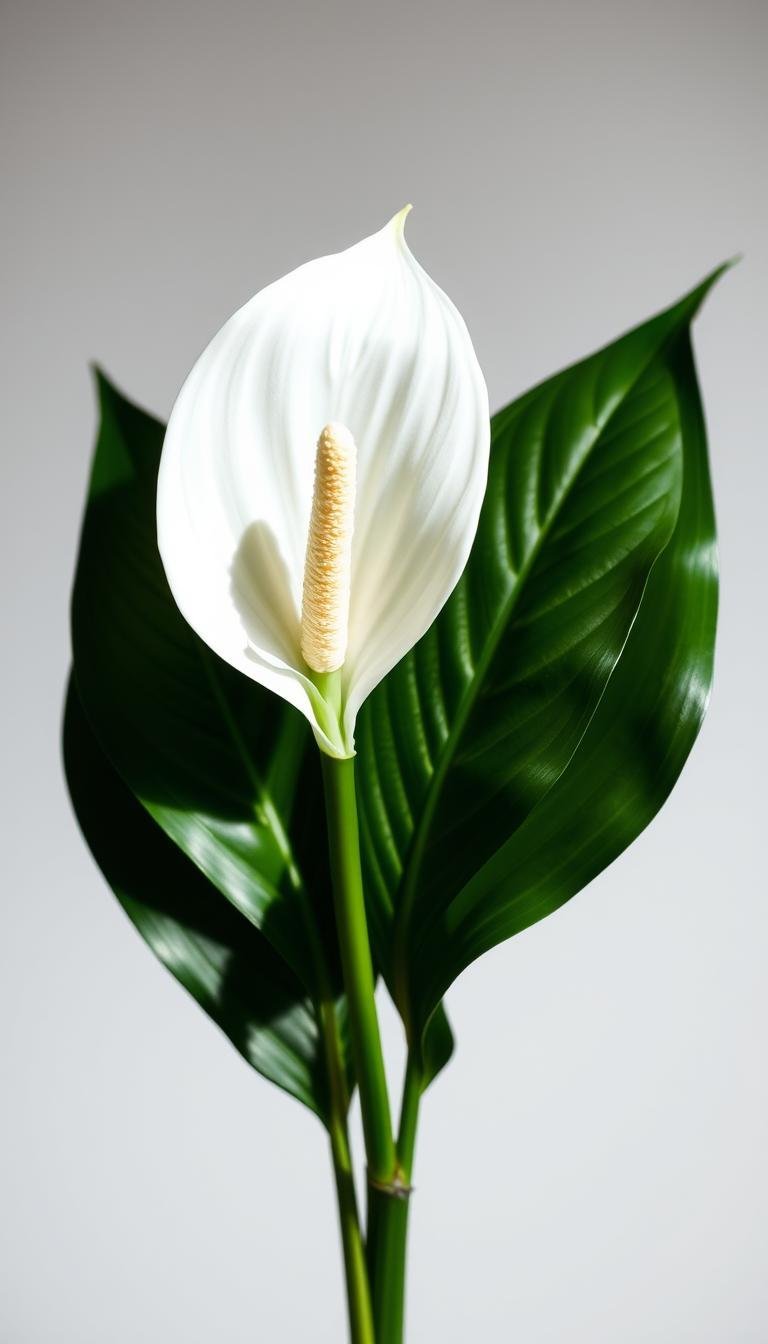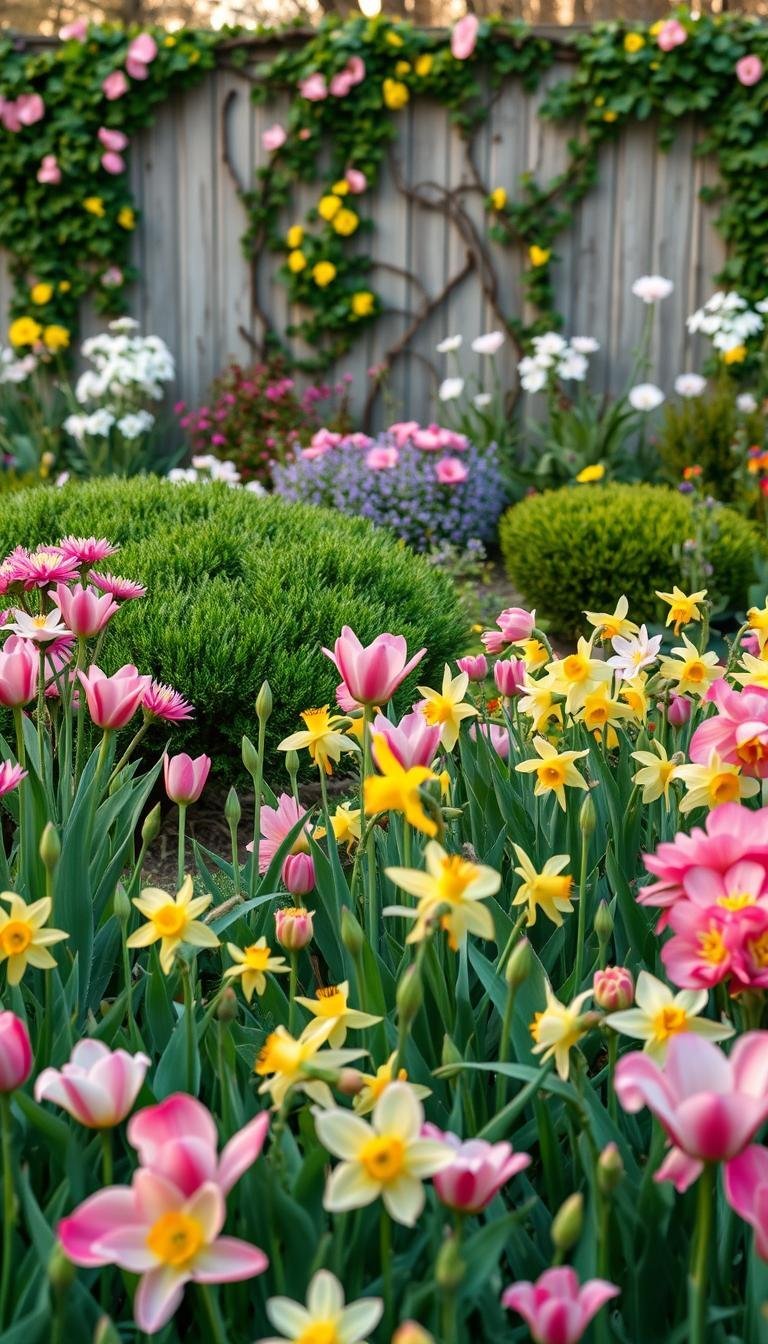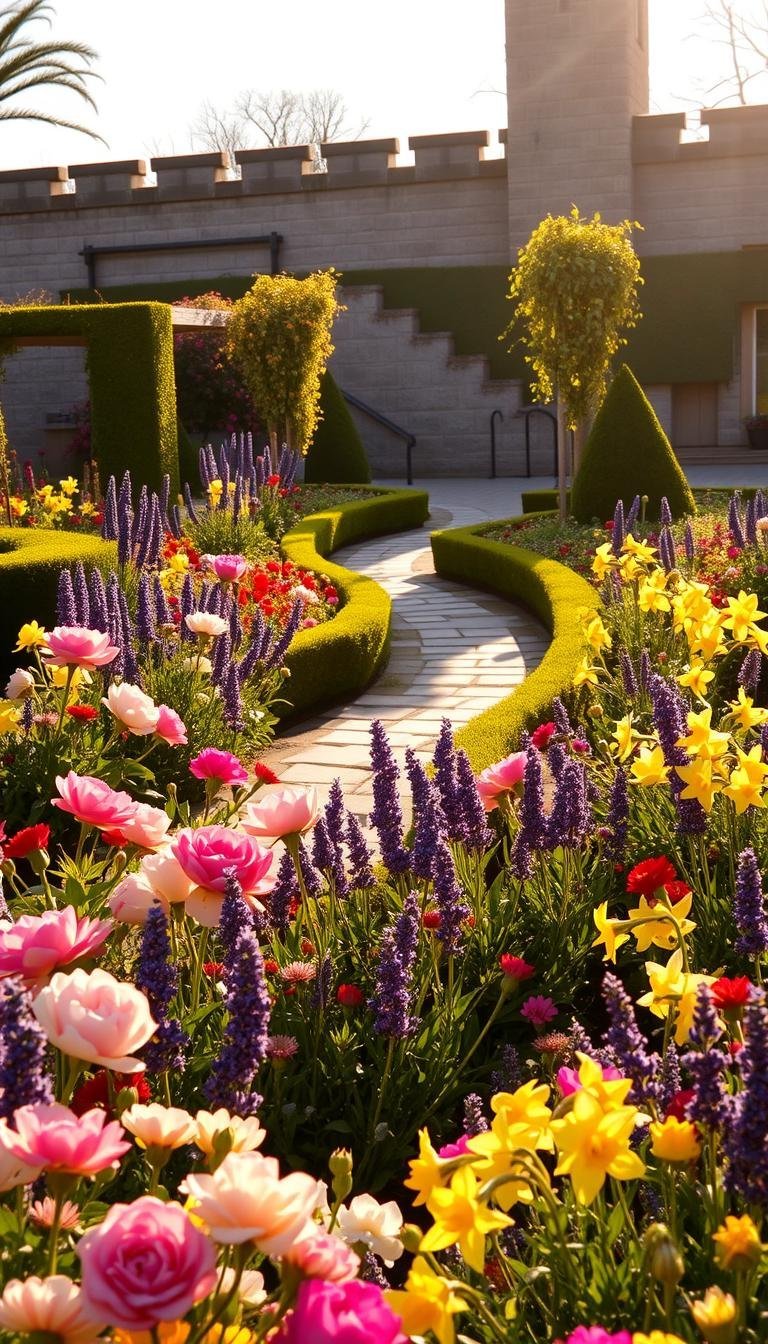This post may contain affiliate links. If you click and buy, we may earn a small commission at no extra cost to you. Learn more.
Starting a garden from scratch is easier than you think. This guide will walk you through every step, from picking the perfect spot to choosing your first plants. You’ll learn the basics of gardening to grow veggies, flowers, or herbs with ease.
Whether you have a small balcony or a big yard, we’ve got you covered. We’ll show you how to get your soil ready, water your plants right, and avoid common mistakes. Our tips are designed for beginners, so you can start enjoying fresh produce or beautiful blooms quickly.
Contents
- 1 Understanding the Basics of Gardening
- 2 Choosing the Right Location
- 3 Selecting the Right Plants
- 4 Preparing Your Garden Soil
- 5 Budgeting for Your Garden
- 6 Essential Gardening Tools
- 7 Creating a Garden Plan
- 8 Sowing Your Seeds
- 9 Watering Your Garden
- 10 Managing Pests and Diseases
- 11 Harvesting Your Crops
- 12 Continuing Your Gardening Journey
Understanding the Basics of Gardening
Gardening is a rewarding way to grow plants and connect with nature. For beginners, how to start a garden for beginners is easier than you think. This section will cover the basics to help you feel more confident and clear.
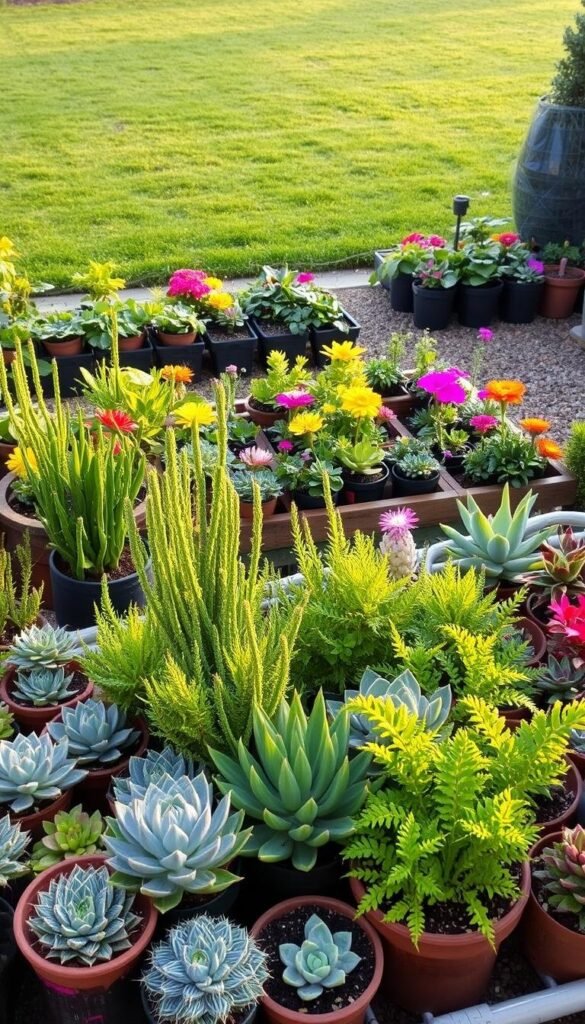
What is Gardening?
Gardening is about growing plants in soil or containers. It can include flowers, vegetables, or herbs. The main goal is to care for life from seeds to harvest, no matter the size of your space.
Benefits of Gardening
Discover why starting a garden is important:
- It reduces stress and boosts your mood through outdoor activities.
- It teaches patience and responsibility through plant care.
- It encourages fresh food production, saving money on groceries.
These beginner gardening tips show how gardening can improve your daily life.
Different Types of Gardens
Choose a style that fits your space and goals:
- Container gardens: Use pots for herbs or flowers on patios.
- Raised beds: Perfect for small yards with rich soil.
- Vertical gardens: Ideal for small spaces using walls or trellises.
- Indoor setups: Grow plants year-round with sunlight or grow lights.
These easy gardening ideas show there’s a method for every lifestyle.
Choosing the Right Location
Starting a garden from scratch means finding the perfect spot. It’s where sunlight, soil, and convenience come together. Simple garden planning helps your plants grow well and makes gardening fun. Here are three important things to think about:
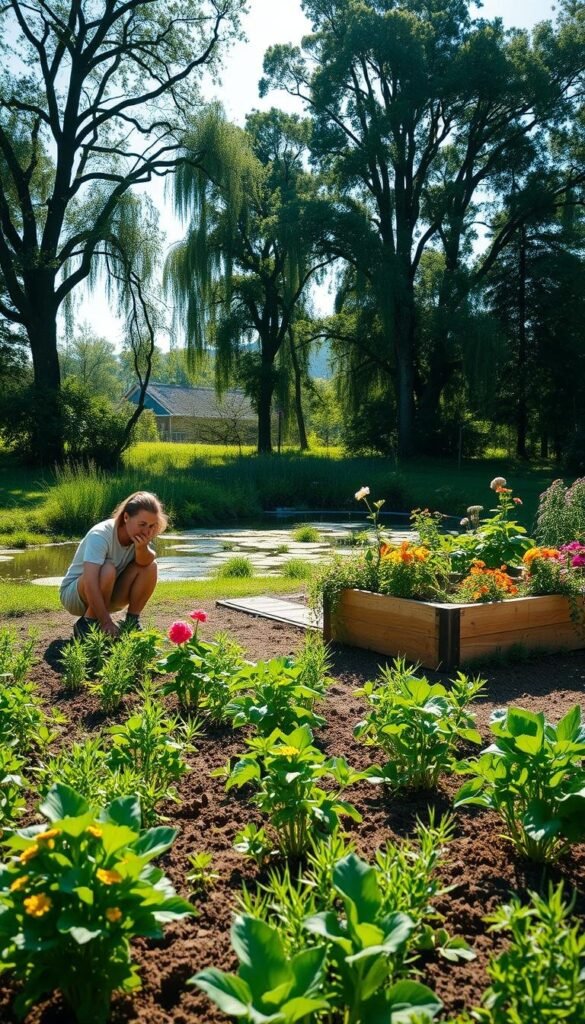
Sunlight Requirements
Watch your yard at different times of day. Most plants need 6–8 hours of sunlight. Keep a notebook to track the sun’s movement over a week.
Full sun spots face south, while north sides are shadier. Plants like herbs do well in partial sun.
Soil Quality
Feel your soil by hand. If it crumbles easily when wet, it’s good. To check drainage, dig a hole, fill it with water, and see how fast it drains.
Avoid areas that stay wet, like near drains or slopes.
Accessibility for Maintenance
- Put gardens near water sources for easy watering.
- Leave 2–3 feet between plants for walking space.
- Avoid hidden corners where plants might be forgotten.
Keep tools handy and paths clear. A well-placed garden makes gardening easier and more rewarding.
Selecting the Right Plants
Your garden’s success begins with the right plant choices. Beginner-friendly gardening focuses on ease and fun. Let’s explore key decisions to make your garden planning simpler.

Vegetables vs. Flowers
- Vegetables like tomatoes or lettuce reward patience with fresh produce but need consistent care.
- Flowers such as marigolds or sunflowers add color and attract pollinators with less daily attention.
- Mix both! A 50/50 split balances beauty and practicality. “Start with what you eat or admire most,” says the National Gardening Association.
Native Plants vs. Non-Native
Native plants like black-eyed susans thrive without extra water or pesticides. Non-natives may need more care. Check local extension services for regional recommendations. Simple garden planning means choosing species that fit your ecosystem.
Seasonal Considerations
Beginner gardening tips always stress timing. Use USDA planting zones to pick frost-hardy options. Spring beginners might start with cool-season crops like peas; fall gardeners can plant kale or pansies.
“Failure to match plants to seasons is a top rookie mistake,” warns gardening educator Karen Smith. “Check last/frost dates for your area first.”
Stick to 3-5 plant types initially. Success builds confidence—and bigger plans for next year!
Preparing Your Garden Soil
Healthy soil is key for a great garden. If you’re starting a garden from scratch or refreshing an old one, getting the soil right is essential. Follow this step-by-step garden setup to make your soil perfect for plants.
Soil Testing
First, find out what your soil needs. Use DIY kits from Luster Leaf or send samples to local labs. Check pH levels and nutrient levels to add the right stuff. A pH test is quick and costs less than $15.
Adding Organic Matter
Make your soil better with compost, leaves, or manure. Spread 2-3 inches of it over the soil. Use a garden fork to mix it in the top 6-8 inches. This helps with drainage and feeds good microbes.
Tilling Techniques
Rototilling breaks up hard soil but might hurt earthworms. For a softer option, try no-till gardening. Just add compost and mulch on top. Pick what’s best for your garden.
Budgeting for Your Garden
Starting a garden doesn’t have to be expensive. With smart budgeting, beginners can grow beautiful plants without spending too much. We’ll look at costs and find ways to save money on every project.
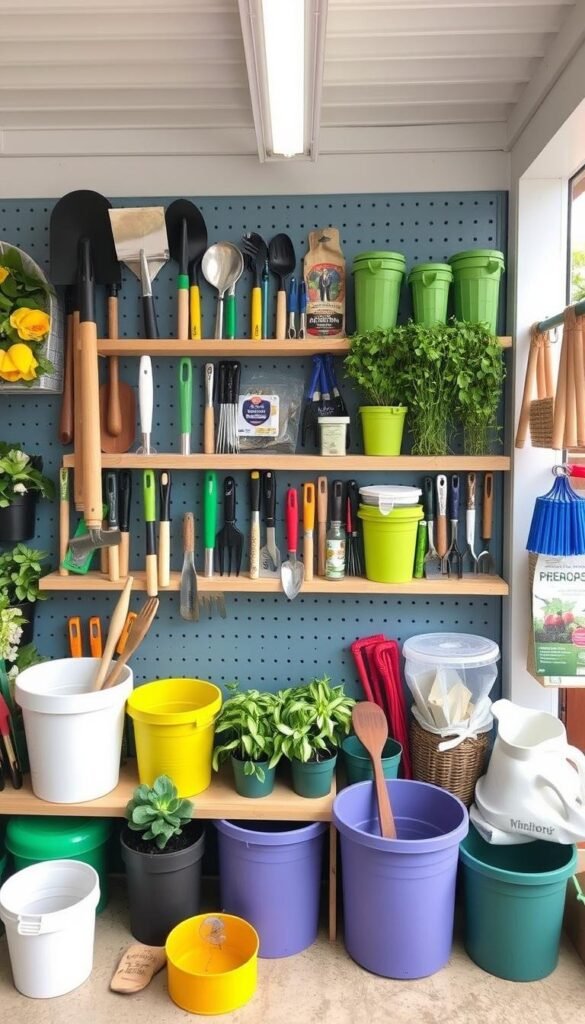
Estimating Costs
The cost of starting a garden can vary. A small 10×10 plot might cost between $50 and $200. This depends on the soil, seeds, and essential gardening supplies you need. Larger gardens might cost more, up to $300 or more for raised beds or irrigation.
Compare prices at local nurseries or online at places like Burpee or Gardener’s Supply Company.
Tools and Supplies Needed
Start with the basics for beginner-friendly gardening:
- Hand trowel: $10–$30 (perfect for planting small seeds)
- Garden gloves: $8–$25 (keep hands safe from dirt and thorns)
- Watering can or hose: $15–$50 (pick based on your garden’s size)
Wait to buy non-essential items like pruners or wheelbarrows until your garden grows.
Alternatives to Buying
Get creative to save money:
- Look into community tool-sharing programs (check local libraries or co-ops).
- Swap seeds with neighbors or attend free seed swaps at garden clubs.
- Use household items like pallets for raised beds or egg cartons for seedlings.
Invest in long-lasting essential gardening supplies like organic mulch. It keeps weeds away and holds moisture well.
Essential Gardening Tools
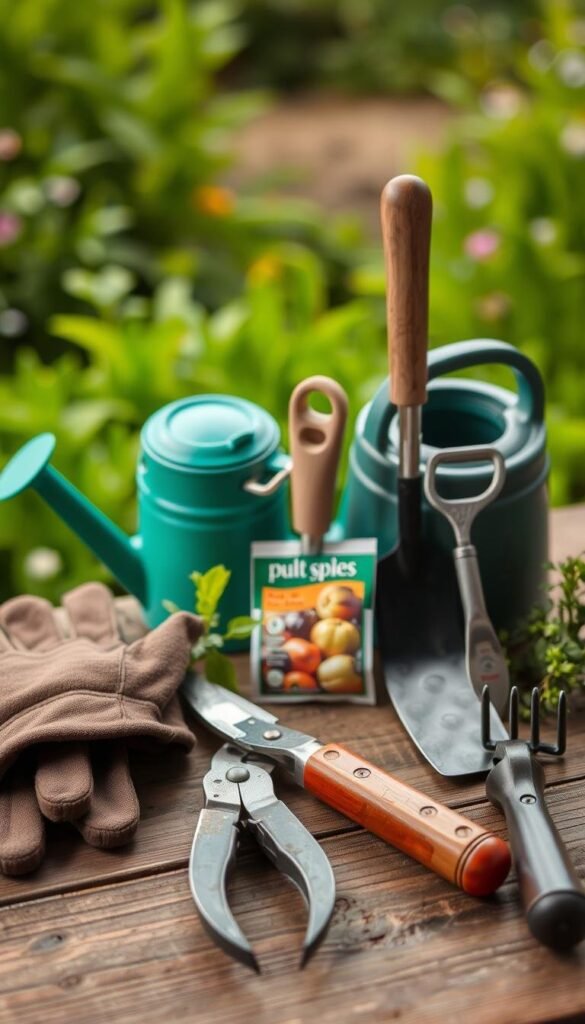
Every gardener needs the right tools to make planting and maintenance easier. These essential gardening supplies are key for beginners. Start with a few high-quality items that handle multiple tasks.
Must-Have Tools for Beginners
- Trowel: A small but mighty tool for digging holes, transplanting, and mixing soil. Look for durable stainless steel models like the Fiskars 6-inch Trowel.
- Pruners: Prune plants and cut stems with bypass pruners like Fiskars Bypass Pruners or Felco 8. Sharp blades prevent damage to plants.
- Garden Gloves: Protect hands with breathable, reinforced gloves from brands like Work ‘N Gear or G&F Supply.
- Watering Can or Hose: Choose a lightweight can for small gardens or a soaker hose for larger spaces.
How to Care for Your Tools
Regular maintenance keeps tools in top shape. Follow these steps:
- Clean blades after each use with a stiff brush to remove dirt and debris.
- Sharpen pruners and trowels with a whetstone every few months for precision cuts.
- Store tools in a dry area to prevent rust. Hang them on a wall hook or use a tool caddy.
Invest in a small oil can to lubricate moving parts and extend tool life.
Where to Buy Gardening Tools
Beginners can find essential gardening supplies at local stores like Home Depot, Walmart, or garden centers. Online retailers like Amazon offer competitive prices. Thrift stores or flea markets are budget-friendly options—check for sharpness and durability before buying. Prioritize ergonomic designs with padded grips to reduce hand strain, a key for comfort.
Creating a Garden Plan
Before you start digging, simple garden planning can save you time and stress. Begin with a simple sketch or use apps like Garden Plan Pro. This helps you map out your garden, including paths, sunlight, and where each plant will do best. A good plan makes your garden dreams come true.
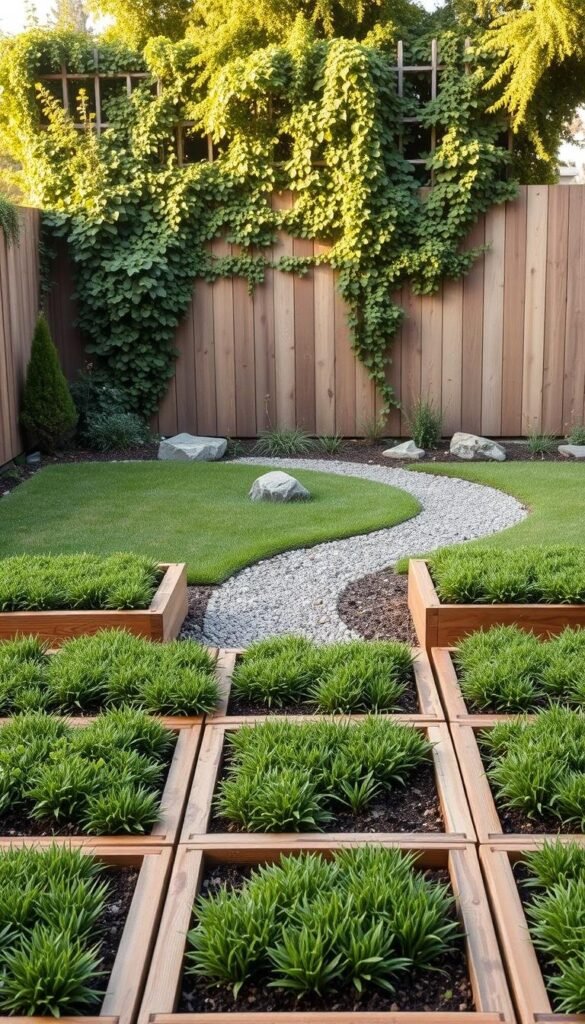
Sketching Your Layout
- Measure your space first—mark walkways and fixed objects.
- Draw sun exposure zones: full sun vs. shady corners.
- Leave room for growth—tomatoes need more space than lettuce.
Plant Spacing and Placement
Follow the spacing tips on seed packets. Too close and plants won’t grow well. Use strings and stakes to mark rows during step-by-step garden setup. Group plants with similar needs together.
Companion Planting Basics
Pairing plants wisely boosts health and yields. Try:
- Tomatoes + basil (deters pests)
- Corn, beans, squash (Three Sisters method)
- Marigolds around roses (naturally repel insects)
These easy gardening ideas help you use space well and save effort. Check your local plant hardiness zones to pick the right plants for your area. Adjust your plans as needed—planning keeps your garden organized and healthy.
Sowing Your Seeds
Starting beginner garden projects means choosing between seeds or seedlings. Both ways can lead to success, but each has its own pace. Let’s explore the options to help you choose what’s best for your How To Start A Garden For Beginners journey.
Seed vs. Seedling: Which to Choose?
- Seeds: They offer more variety and are cheaper. Ideal for beginner-friendly gardening favorites like lettuce or sunflowers.
- Seedlings: Best for slower-growing plants like tomatoes. They save time but cost more at first.
When to Plant: Timing Is Key
Check local frost dates. Cool-season veggies like peas do well in spring. Peppers need warm soil in late spring. Use a soil thermometer to check if the temperature is right for your plants.
Proper Planting Techniques
Follow these steps for success:
- Plant seeds at twice their diameter depth. For example, radish seeds should be ½ inch deep.
- Space seeds as the packet instructions suggest to avoid overcrowding.
- Water gently with a spray bottle to prevent soil compaction.
Patience is key! Germination takes time—most seeds sprout in 7–21 days. If seeds don’t sprout, check the soil’s moisture and temperature. Every sprout is a victory!
Watering Your Garden
Learning to water is key for beginner gardening tips. Too much or too little water can harm plants. This guide offers easy gardening ideas to keep your plants healthy, even if you’re starting from scratch.
Understanding Water Needs
Every plant has its own water needs. For instance:
- Tomatoes like consistent moisture but don’t like wet soil.
- Rosemary prefers dry soil between waterings.
- New seedlings need gentle watering to avoid root rot.
Methods of Watering
Choose the best method for your garden:
- Hand watering: Perfect for small gardens. Use a gentle spray nozzle to avoid damaging roots.
- Soaker hoses: Slowly drip water directly to roots, saving time and water.
- Drip irrigation: Great for raised beds or large areas, reducing evaporation.
Signs of Overwatering or Underwatering
Look out for these signs:
- Overwatering: Yellow leaves, mold on soil, or mushy stems.
- Underwatering: Wilting leaves that don’t recover overnight, dry soil deeper than 2 inches.
Aim to water early morning or late afternoon. This cuts evaporation and protects roots.
Adjust your watering based on the weather. Rainy days mean less water. Dry spells need deeper soakings. Always check soil moisture before watering—dig your finger 2 inches into soil. If dry, it’s time to water!
Managing Pests and Diseases
Every garden has its challenges, but new gardeners can overcome them. For beginner-friendly gardening, it’s important to spot problems early and use gentle solutions. This section will show you how to keep your garden healthy without harmful chemicals.
Identifying Common Garden Pests
Spotting pests early is key to preventing damage. Look out for:
- Aphids: They form clusters on stems or leaves.
- Slugs: You’ll see silvery trails and chewed leaves.
- Spider mites: They leave fine webs and turn leaves yellow.
Organic Pest Control Methods
Here are some beginner garden projects to fight pests:
- Physical barriers: Use floating row covers to keep insects away.
- Companion planting: Marigolds keep beetles away; basil keeps mosquitoes off.
- Homemade sprays: Mix 1 tbsp neem oil + 1 tsp dish soap in 1 quart water for a natural bug killer.
Keeping Your Plants Healthy
Strong plants are the first step to a healthy garden. Make sure:
- Plants are spaced right for good airflow.
- Mulch the soil to keep it moist.
- Clean your tools and remove sick leaves quickly.
Regular checks and quick action keep your garden in balance. Remember, some pests are good, like ladybugs eating aphids. So, identify them before you react!
Harvesting Your Crops
Getting the most from your garden starts with knowing when to pick. If veggies are too ripe, they lose flavor. But waiting too long means missing out. Use a calendar or journal to track planting dates and make harvesting easier.
When and How to Harvest
Check the plant tags or seed packets for days-to-maturity numbers. Look for signs like tomatoes turning red or zucchini staying firm. Use clean shears or your hands to avoid damaging the stems. Harvest beans and peas often to encourage more growth.
Storage Made Simple
- Leafy greens like lettuce do well in damp paper towels in sealed bags.
- Root veggies such as carrots keep well in a cool basement in sand or soil.
- Freeze herbs in ice cube trays with water or olive oil for winter use.
Enjoy the Bounty
Make zucchini into fritters or grate it into pancakes. Roast cherry tomatoes with garlic for pasta toppings. Try easy gardening ideas like salsa with fresh peppers, onions, and cilantro. Local farmers markets are great for swapping extra produce.
Every bite of homegrown food connects you back to your garden. Share extras with neighbors to build community and share gardening tips!
Continuing Your Gardening Journey
As your first garden season ends, you’ve learned a lot and had some wins. To keep improving, focus on small steps. These steps will help you build lasting gardening habits.
Preparing for Next Season
After the harvest, clean and store your tools well to make them last longer. Add compost or mulch to your soil to keep it rich. Look over your step-by-step garden setup notes to make changes for next year.
Remember the dates you planted and any pest problems. This will help you plan better for the future.
Joining Local Gardening Communities
Join groups like the National Garden Clubs or local Master Gardener programs. They’re great for sharing tips. You can also attend plant swaps or join online forums like GardenWeb.
Getting advice from experienced gardeners can help you solve problems faster than just beginner gardening tips.
Resources for Learning More
Improve your skills with books like “The Vegetable Gardener’s Bible” or free webinars from The Gardening Channel. Listen to podcasts like “Plant Amnesty” for tips and encouragement. Don’t forget to check out GrowVeg for starting a garden from scratch next time.
Gardening is all about learning and growing. Every problem, from wilted leaves to overripe tomatoes, teaches you something new. Celebrate your small wins, adapt for next year, and let your curiosity lead you to new adventures in gardening.
To bring you cozy inspiration more efficiently, we sometimes use AI to assist in content creation — but every word and idea is carefully shaped by our team. See our AI Disclosure for more info.

